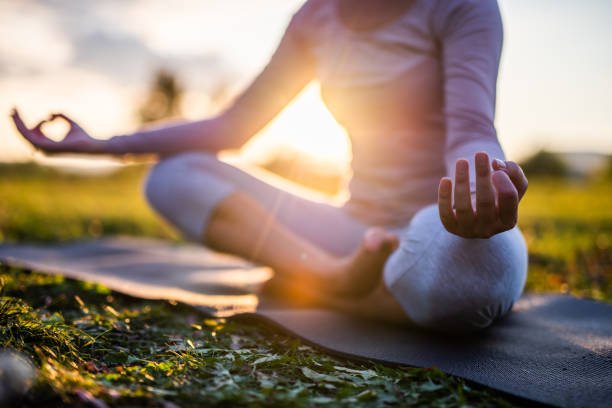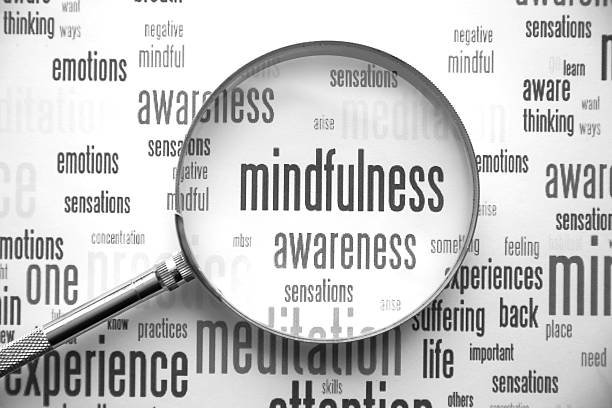Hey there, friend! Welcome back to the Unplugged Routine, your go-to space for finding more calm and intention in your daily life.
Does this morning sound familiar? The alarm jolts you awake, and before your feet even hit the floor, your mind is already racing. You rush through a shower, your thoughts on the first meeting of the day. You gulp down coffee while scrolling through emails, your breakfast a forgotten blur. You navigate traffic on autopilot, arriving at your destination feeling like you’ve already run a marathon. The day has taken control before you’ve had a chance to even connect with it.
This state of constant, frazzled autopilot is the default for so many of us. But what if there was a way to gently press pause? A way to start your day with clarity and intention, rather than chaos and reaction? That’s where the quiet power of a daily mindfulness practice comes in.
You’ve undoubtedly heard the buzz about mindfulness – its incredible, science-backed benefits like reduced stress, sharper focus, better sleep, and a greater sense of overall well-being. But knowing why it’s good for you and figuring out how to actually build it into your already packed life are two very different things. The thought of starting can feel intimidating.
That’s why we’ve crafted this friendly, deeply practical guide on how to start a daily mindfulness practice. Forget any pressure or perfectionism. We’ll break down the process into seven simple, manageable steps, offering real-world tips and tons of encouragement. Think of this as your personal roadmap to weaving moments of presence into the fabric of your day, supercharging your well-being from the inside out.

Table of Contents
Why Make it Daily? The Transformative Power of Consistency
Before we dive into the “how,” let’s spend a moment on the profound “why” of a daily practice. Occasional meditation is like going for a hike once a season – it’s nice, but it won’t make you fundamentally fitter. Daily practice, even for a few minutes, is like daily gentle exercise for your brain. It literally rewires your mind for the better.
This process is known as neuroplasticity—the brain’s amazing ability to reorganize itself by forming new neural connections. When you practice mindfulness daily, you are actively sculpting your brain. You strengthen the prefrontal cortex, the part of your brain responsible for focus, rational decision-making, and emotional regulation. Simultaneously, you help to calm the amygdala, your brain’s “threat detector,” which can reduce feelings of stress and anxiety.
This isn’t just abstract science; it translates into real-life changes. Consistent practice helps you regulate your body’s stress response, meaning you become less reactive to daily annoyances. It improves your attention network, allowing you to focus more deeply on tasks and be more present in conversations with loved ones. It creates a precious “pause” between a stressful event and your reaction to it, giving you the freedom to choose a wiser, calmer response.
Perhaps most importantly, a daily practice is a profound act of self-compassion. It’s a non-negotiable appointment with yourself where you practice being aware and kind. In a world that constantly demands you do more, be more, and achieve more, taking a few minutes to simply be is a revolutionary act of self-care. This compassionate approach is foundational, and for those wanting to explore it further, the research and guided exercises from Dr. Kristin Neff, a leading expert on self-compassion, are an invaluable resource.
Your 7-Step Guide: How to Start a Daily Mindfulness Practice
Ready to build this life-enhancing habit? Here is your simple, actionable blueprint. Remember, the goal is progress, not perfection.
Step 1: Start Absurdly Small and Be Realistic
The number one reason people give up on new habits is that they bite off more than they can chew. The initial burst of motivation has us aiming for a 30-minute meditation session, but by day three, life gets in the way and we feel like we’ve failed.
Let’s flip the script. Commit to something so small it feels almost too easy. Can you commit to just three to five minutes a day? That’s it. One single song’s length. This “micro-habit” approach removes the intimidation factor and makes it incredibly easy to say “yes” each day. You can always do more if you feel like it, but the daily goal is just five minutes. Consistency is what rewires the brain, so a short daily practice is infinitely more powerful than a long, infrequent one.
Step 2: Choose a Consistent Time and Place
Habits thrive on routine. Just as you brush your teeth at the same time each day, scheduling your mindfulness practice helps to cement it into your life. The key is to find a time and place that genuinely works for your schedule and energy levels.
- Morning Practice: Many people find success by meditating first thing in the morning, before the day’s demands begin. It can set a calm, focused tone for the hours ahead.
- Midday Reset: A short practice during your lunch break can be a powerful way to release morning stress and reset your focus for the afternoon.
- Evening Wind-Down: Meditating before bed can help you let go of the day’s worries, calm a racing mind, and prepare your body for more restful sleep.
Experiment for a week and see what feels best. Once you have your time, find a dedicated space. It doesn’t need to be a special room. It can simply be the same comfortable chair, the same corner of your bedroom, or even your parked car before you walk into the office. This consistency of place helps signal to your brain that it’s time to shift into mindfulness mode.
Step 3: Find Your Anchor (Your Mind’s Home Base)
Your “anchor” is the neutral point of focus you’ll return to whenever your mind wanders. It’s the home base for your attention. For most beginners, the physical sensation of the breath is the most accessible anchor.
You can focus on:
- The cool air entering your nostrils and the warm air leaving.
- The gentle rise and fall of your chest.
- The expansion and contraction of your belly.
Try each one and see which feels most distinct to you. Your anchor isn’t something you need to control; you’re just resting your awareness on its natural rhythm. If the breath doesn’t work for you, you can also use the feeling of your hands resting in your lap or your feet on the floor as your anchor.
Step 4: Make it Effortless to Begin
The secret to building any new habit is to reduce the “friction” it takes to start. Make it so easy to begin that you have no excuse.
- Prepare the Night Before: If you plan to meditate in the morning, set out your cushion or place a small note on your coffee machine before you go to bed.
- Use Technology Wisely: Meditation apps like Calm, Headspace, or Insight Timer are fantastic tools for beginners. They take the guesswork out of timing and provide gentle guidance. Bookmark a favorite guided meditation so it’s ready to go with one click.
- Create a Cue: Have a clear trigger for your practice. It could be finishing your morning coffee, turning off your work computer, or changing into comfortable clothes.
The fewer decisions and steps you have to take in the moment, the more likely you are to follow through.
Step 5: Master the Gentle Return (This is the REAL Practice)
Here’s the most important secret to mindfulness: your mind will wander. It will drift to your to-do list, an old memory, a random itch, or what to have for dinner. This is not a failure. In fact, it’s the entire point.
The actual “exercise” of mindfulness is the moment you notice your mind has wandered and then gently and kindly guide it back to your anchor.
Imagine you’re training a playful puppy. When the puppy wanders off, you don’t yell at it. You gently call its name and guide it back. Treat your mind with that same patient, compassionate attitude. Every single time you notice a thought and return to your breath, you have successfully completed a full “rep” of mindfulness. The practice isn’t about staying perfectly focused; it’s about the gentle, repeated act of returning.
Step 6: Link It to an Existing Habit (The Power of Habit Stacking)
This is a game-changing technique from behavioral science. Habit stacking involves attaching your new desired habit to an existing, solid routine. This leverages an established neural pathway in your brain to help build the new one.
Think about your unshakable daily habits. Do you always brush your teeth? Make coffee? Change out of your work clothes? Link your new practice directly to one of these.
- “After I brush my teeth in the morning, I will sit and meditate for five minutes.”
- “After I pour my first cup of coffee, I will do my mindfulness practice.”
- “As soon as I walk in the door from work, before I do anything else, I will meditate.”
This creates an automatic trigger, removing the need to rely on willpower or memory alone.
Step 7: Acknowledge Your Effort (Not Your Performance)
While mindfulness is about being non-judgmental, acknowledging your consistency can be a powerful motivator. This isn’t about rating your session as “good” or “bad.” It’s about celebrating the simple act of showing up for yourself.
You could:
- Put a simple “X” on a wall calendar for each day you practice.
- Use a habit-tracking app to build a “streak.”
- Keep a simple journal and write one word describing how you feel after your practice.
Seeing a visual representation of your commitment can provide a huge boost and encourage you to keep the momentum going, especially on days when you don’t feel motivated.

Conclusion: Your Daily Dose of Calm is Waiting
Starting a daily mindfulness practice is one of the most profound acts of self-care you can undertake. It is a quiet rebellion against the frantic pace of modern life and a commitment to your own well-being. It’s not about adding another stressful “to-do” to your list, but about creating a space of “to-be”—a space to be present, to be aware, and to be kind to yourself.
By starting absurdly small, staying consistent, and treating yourself with endless compassion, you can build a practice that doesn’t just supercharge your day but truly transforms your life from the inside out.
Ready to take the very first step on this incredible journey? Here is your call to action: Right now, open the calendar on your phone. Choose a 5-minute slot for tomorrow and create an event called “My Mindfulness Practice.” That’s it. You have officially begun.
For guided meditations, further reading, and a community to support you, continue to explore unpluggedroutine.com. We are so excited for you to discover the peace and clarity that awaits. Share your commitment in the comments below—when is your 5-minute appointment with yourself?